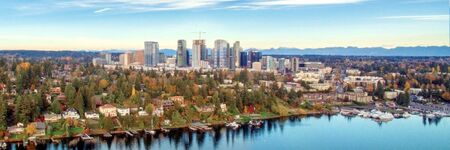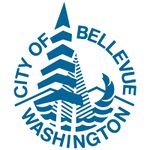Bellevue WA
- Members
Bellevue is a city in the Eastside region of King County, Washington, United States, located across Lake Washington from Seattle. It is the third-largest city in the Seattle metropolitan area and has variously been characterized as an edge city, a suburb, boomburb, or satellite city. Its population was 122,363 at the 2010 census and 151,854 in the 2020 census. The city's name is derived from the French term belle vue ("beautiful view").
Activities

|
Smart Cities Dashboard in the City of Bellevue WA | |
Install a pilot GIS-based visual dashboard to provide improvements in the following sectors:
| ||
Details
Bellevue is home to some of the world's largest technology companies. Prior to 2008, its downtown area underwent rapid change with many high-rise projects being constructed, and was relatively unaffected by the economic downturn. Downtown Bellevue is currently the second-largest city center in Washington state, with 1,300 businesses, 45,000 employees, and 10,200 residents. In a 2018 estimate, the city's median household income was among the top five cities in the state of Washington. In 2008, Bellevue was number one in CNNMoney's list of the best places to live and launch a business, and in 2010 was again ranked as the fourth-best place to live in America. In 2014, Bellevue was ranked as the second-best place to live by USA Today.
More than 145 companies have been located in Bellevue; companies currently headquartered there include PACCAR Inc, T-Mobile, and Valve. The technology company Amazon was founded in Bellevue by Jeff Bezos.
- History
The Duwamish, whose main settlements were located in present-day Renton and Seattle, maintained a small outpost settlement called Satskal (SAH-tsah-kahl) along the Mercer Slough, south of present-day downtown Bellevue.; It was from this village that an attack on the settlers of Elliott Bay was staged. The Duwamish also had a village near Factoria called 'pah-pah-DEEL'.;
Bellevue was first settled by European Americans in 1869 by William Meydenbauer and Aaron Mercer, who claimed homestead tracts several miles apart. Both moved away within a few years, and permanent residents did not arrive until 1879. By 1882, a community, consisting mostly of logging homesteaders, had established itself.; Once the land had been logged, it was gradually cleared, largely by Japanese immigrant labor in the early 20th century, to support small-scale farming on leased land plots.;
By the early part of the 20th century, Bellevue had acquired a reputation as a weekend getaway destination for Seattle residents, who would arrive by ferry at Meydenbauer Bay and spend the day at nearby Wildwood Park. After the ferry landing was moved to Medina, however, tourism to Bellevue waned. To counter this decline, the Bellevue Strawberry Festival was conceived of in 1925, and by the 1930s it had grown to attract as many as 15,000 visitors. At the time, Bellevue was still a small town with around 2,000 residents.
Prior to the opening of the Lake Washington Floating Bridge in 1940, Bellevue was mostly rural farmland area with little development. Although it was small, developers were pushing to change that; in the 1920s, James S. Ditty predicted that it would become a city with a population of 200,000. He envisioned plans that included the bridging of Lake Washington and an area filled with golf courses and airports. His map with these visions was published in 1928. Once the Murrow Memorial Bridge opened, access from Seattle improved, and the area began to evolve into a bedroom community.
In 1942, the Bellevue Strawberry Festival was cancelled. The primary reason was that some 90 percent of the agricultural workforce in the area was of Japanese ancestry, and all of these farmers and their families had been forcibly interned in camps following the start of World War II. The fair would not be revived for another 45 years. Following the expulsion of the ethnic Japanese farming community, a large quantity of farmland became available for development. This made way for the initial development of the Bellevue downtown area.
Bellevue incorporated as a third-class city on the March 31, 1953. Following the 1963 opening of a second bridge across the lake, the Evergreen Point Floating Bridge, the city began to grow more rapidly. The Crossroads community was annexed in 1964. Lake Hills was annexed in 1969. By the 1970 census, Bellevue had become the fourth most populous city in the state of Washington, behind only Seattle, Spokane, and Tacoma.
Bellevue remains one of the largest cities in the state, with several high-rise structures in its core and a burgeoning business community. The city experienced a building boom during the mid-2000s, with the building of developments such as Lincoln Square and the Bravern.
Bellevue Square is located in downtown Bellevue and is now one of the largest shopping centers in the region. Opened in 1946, the mall has undergone several significant phases of expansion since the 1980s. The city's plans include the Bel-Red Corridor Project, a large-scale planning effort to encourage the redevelopment of the large Bel-Red section of the city bordering the adjacent town of Redmond which is a major employment area in the city. Patterned after the redevelopment of the downtown core, plans include superblock mixed-use projects similar to Lincoln Square, premised on private construction and the development of infrastructure such as the extension of Link light rail to the Eastside.
- Geography
Bellevue lies between Lake Washington to the west and the smaller Lake Sammamish to the east. Much of Bellevue is drained by the Kelsey Creek watershed, whose source is located in the Larsen Lake and Phantom Lake green belt and whose outlet is near where Interstate 90 meets Lake Washington's eastern shore. The city is bisected by Interstate 405 running north–south, and the southern portion is crossed from west to east by Interstate 90. The State Route 520 freeway roughly delineates the upper reaches of Bellevue.
According to the United States Census Bureau, the city has a total area of 36.47 square miles (94.46 km2), of which 31.97 square miles (82.80 km2) is land and 4.50 square miles (11.65 km2) is water.
The city's name is derived from a French term for "beautiful view". Under favorable weather conditions, scenic vistas of the Olympic Mountains and Cascade Mountains can be viewed from hilltops (and strategically positioned high-rise buildings) within the incorporated city.
South of I-90, the city continues up Cougar Mountain, at the top of which is an unincorporated King County location called Hilltop. To the west of Cougar Mountain, Bellevue includes the Coal Creek, Somerset, and Factoria neighborhoods.
Bellevue is bordered by the cities of Kirkland to the north and Redmond to the northeast along the Overlake and Crossroads neighborhoods. Across the short East Channel Bridge, I-90 connects Bellevue to Mercer Island to the southwest. Issaquah is to the east, down I-90 at the south end of Lake Sammamish. The city is bordered to the west by many affluent suburbs such as Medina, Clyde Hill, Hunts Point and Yarrow Point. The south end of Bellevue is bordered by the city of Renton, and to the southeast, the relatively recently incorporated city of Newcastle.




